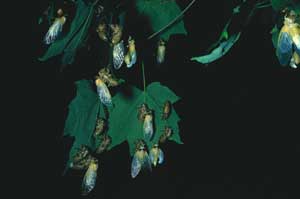|
|
 4 periodical cicadas DHJanzen100395.jpg high resolution
|
|
| The periodical cicadas (Magicicada spp., Cicadidae) offer a superb example of semelparous predator satiation. Right now, on campus, there are millions of nymph cicadas underground sucking on the roots of campus trees. One year, the same year, all will finish nymphal development, crawl to the surface, climb up on foliage, and moult to adults (as is happening in this image in Indiana in 1970). The highly edible adults will court loudly and ostentatiously by the millons, hardly attempt to escape from any individual predator attack, lay their eggs, and die. And the nymphs will live underground for another 13 or 17 years (I do not know whether UPENN is occupied by the 13- or 17- year species). And during the emergence, EVERYBODY eats cicadas. While there are many other species of cicadas (and all grow slowly underground on their low-grade food, using 3-15 years for development), the others are not synchronized (they are semelparous) and they are very alert as individuals to avoid predators. Originally, there were a number of periodical cicada cohorts scattered across North America, of at least two (and perhaps more) species. Within a site, a cohort is highly synchronized, with the tails of the emergence distribution being trimmed from each brood (cicadas emerging after 16 or 18 years, for example, would fare very poorly, given their propensity to not avoid predators). And several cohorts may occupy the same place (presumably due to a given cohort expanding or shifting its range). Deforestation has done to the periodical cicadas what building dams has done to the salmon in their rivers. | ||
back to lecture slides
or skip to: